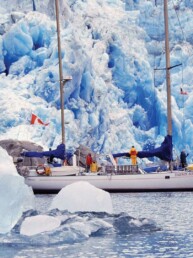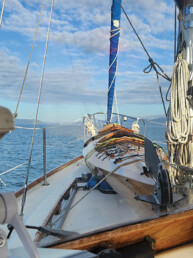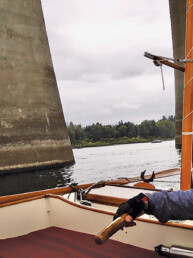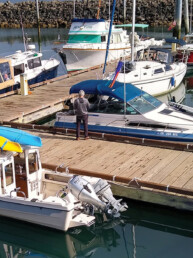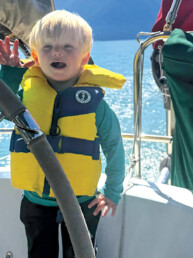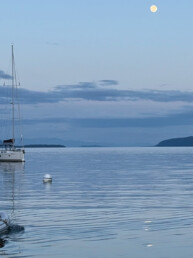Crossing the I-5 bridge between Portland, Oregon and Vancouver, Washington, a driver might spot boats on the Columbia River below, several dozen, perhaps, under sail or power. Noticing a few marinas as well, our observant traveler might suppose that in those thirty seconds, he or she had taken in the totality of Portland’s boat scene. But anyone stuck in a traffic jam, with the time to look more carefully, would soon discover the hidden world of activity existing around the utilitarian interstate bridge.
The main bridge’s southern footings land squarely on Hayden Island, where Washington-based shoppers exit for their sales tax-free fix. But from the second bridge span, which crosses a large channel between Hayden Island and the mainland, another realm is visible: boathouses, houseboats, and all manner of other watercraft. From the channel below, with all this marine activity to observe, the freeway is hardly noticeable.

Hayden (and it’s land bridge-bound partner, Tomahawk Island), comprise about 800 acres, encompassing everything from wildlife habitat to barge anchorages. On a sunny day last summer, my friend Bill and I circumnavigated this microcosm of the lower Columbia River under sail.
Starting from the Gleason Boat Ramp near the airport, we tacked into the wind and headed down the main stem of the river to Tomahawk Island. Its man-made bays harbor at least three marinas, few clearly visible from I-5. Down here on the water, though, boathouses lined the shores, along with hundreds of boats. A little further down, we’re surprised to see a waterfront mobile home park, just below the railroad bridge separating the more developed part of the island from the cottonwood zone.

In the 400-acre cottonwood zone, tall trees created inviting shady spots, sandy beaches tempted us to stretch our legs; and the occasional dirt track emerging from the woods made Portland, with all its concrete, seem far away.
As we turned near the bottom of the Hayden Island, four moored grain barges towered over our small boats. Across the channel separating Hayden from the mainland, the Port of Portland’s shuttered container ship cranes lay dormant. We passed a yacht anchored near the sandy shore, its inhabitants sunbathing and swimming in the brownish water, lending an unexpectedly tropical air to the Columbia.

With the wind and tide pushing upriver, we scooted along without needing to tack. After the pleasant monotony of the cottonwood forest, the community of houseboats we spotted next was a colorful contrast. Furthest downriver were the most creative dwellings, clearly homemade, some painted in shockingly bright colors. People sitting on decks waved from their dream homes. Further upriver, the houses were more formal and professionally built, featuring round windows, towers, waterslides, and multiple stories. Here, too, people waved and smiled as we passed by. Then came a floating restaurant, a kayak shop, a yacht brokerage and more houseboats.


As we pulled towards the uninhabited, sandy upstream tip of Hayden Island, we spotted a handful of folks lounging on inflatable rafts in the shallows, enjoying the sunny day. If we hadn’t been in boats ourselves, we wouldn’t have seen them at all. That’s the way it is on most of Hayden Island: a world of activity visible only from the water.

